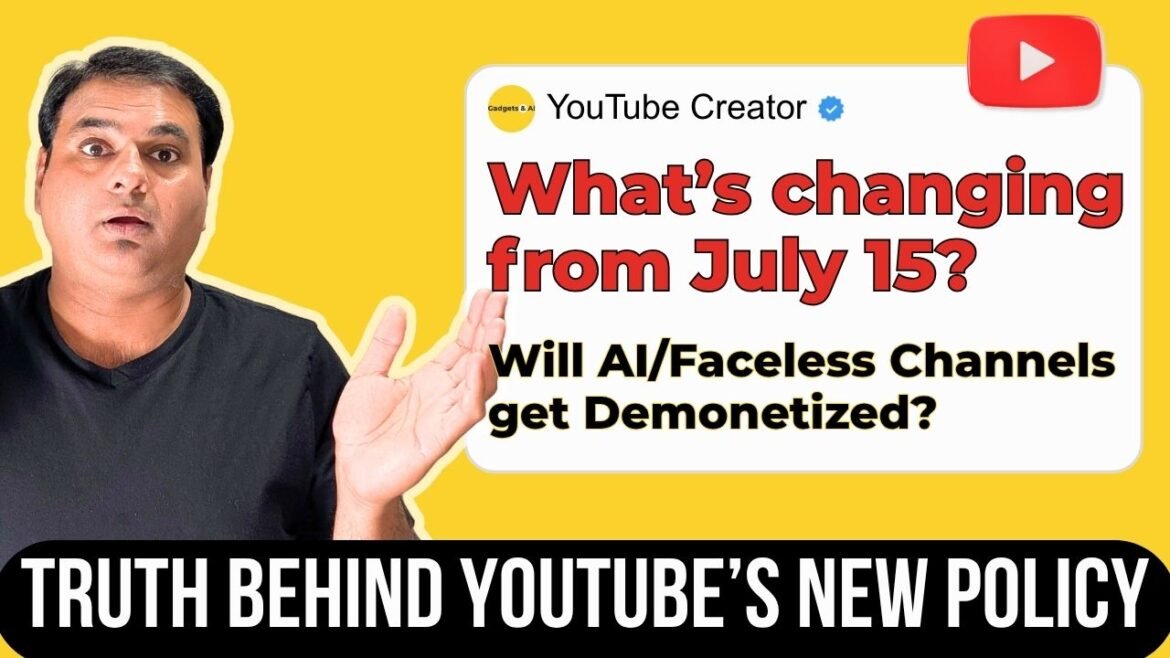Table of Contents
There’s been a lot of rumors, headlines, and heated YouTube community discussions going on online ever since YouTube’s monetization policy update in 2025. If you’ve been reading on Twitter (X), scrolling Reddit threads, or catching creator commentary videos, chances are you’ve seen some bold claims like:
“YouTube will ban AI voices!”
“Faceless channels are getting demonetized!”
“You can’t use stock footage anymore!”
“You can’t upload bulk videos any more!”
And it’s quite obvious, this has led to a lot of stress, especially for creators who rely on automation tools, AI voiceovers, or repurposed content workflows. But here’s the deal: not everything you hear online is true.
In this post, we’re going to bust those myths floating all over the internet and clarify exactly what the updated policy means, without the fear-mongering, but also without sugarcoating. Whether you’re a brand-new YouTuber or a seasoned creator, this is your ultimate guide to staying monetized, compliant, and confident in 2025.
Myth #1: “AI Voiceovers and Content Are Banned”
Well that’s not fully true, AI-generated voices are not banned. YouTube has not banned AI narration or voiceovers created using tools like ElevenLabs or TTS software. The policy update focuses not on the voice itself, but on the intent and effort behind the content.
If you’re scripting your video thoughtfully by yourself, thoroughly researching your topic, and adding your own efforts and creativity, and then recording the script using AI voice over, that’s absolutely fine. YouTube has clearly stated:
“YouTube allows the use of synthetic voices as long as the content is original and adds value to viewers.”Read Policy Details here:
https://support.google.com/youtube/answer/1311392?hl
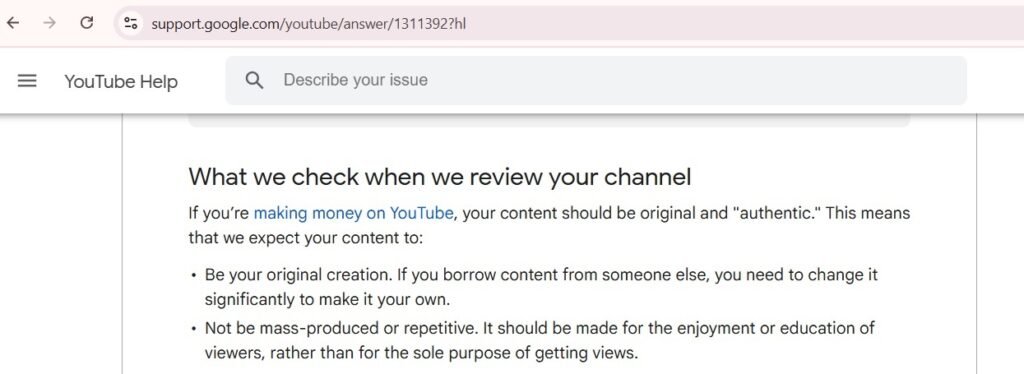

What they are trying to prevent is the bunch of low-effort, mass-produced videos that are becoming common all across the youtube in long form as well as shorts. Just think of it, someone copy-pasting articles from Wikipedia or scrapping reddit threats and using ChatGPT to generate a bland script, and then uploading hundreds of videos read by a AI voice with no editing, pacing, efforts or unique insight. That’s what YouTube calls “low-effort reused content,” and that’s what gets demonetized.
Bottom line: AI voices are tools, not shortcuts. You’re totally safe using AI Voices as long as you’re putting in genuine creative effort in your each and every videos.
Myth #2: “Faceless Channels Can’t Be Monetized Anymore”
This one’s probably the most misunderstood policy change. Let’s clear it out, No, YouTube is not cracking down on faceless creators. I believe faceless doesn’t mean thoughtless or soulless. If you don’t want to show your face, that’s perfectly fine. You can run a documentary channel, an animation explainer series, or a podcast-style voiceover channel and still be monetized.
What YouTube wants is authentic, valuable content, even if it is presented with your face or faceless. What they don’t want is videos like some no effort motivational videos, generic top-10 list pulled from random websites and recorded by a generic AI voice with no editing, no thought, and no originality. That’s where the problem lies, not in the fact that your face isn’t visible.
As stated in the official monetization guidelines:
“The substance of each video should be relatively varied.” “Content should be original and ‘authentic.’ … Not be mass‑produced or repetitive.”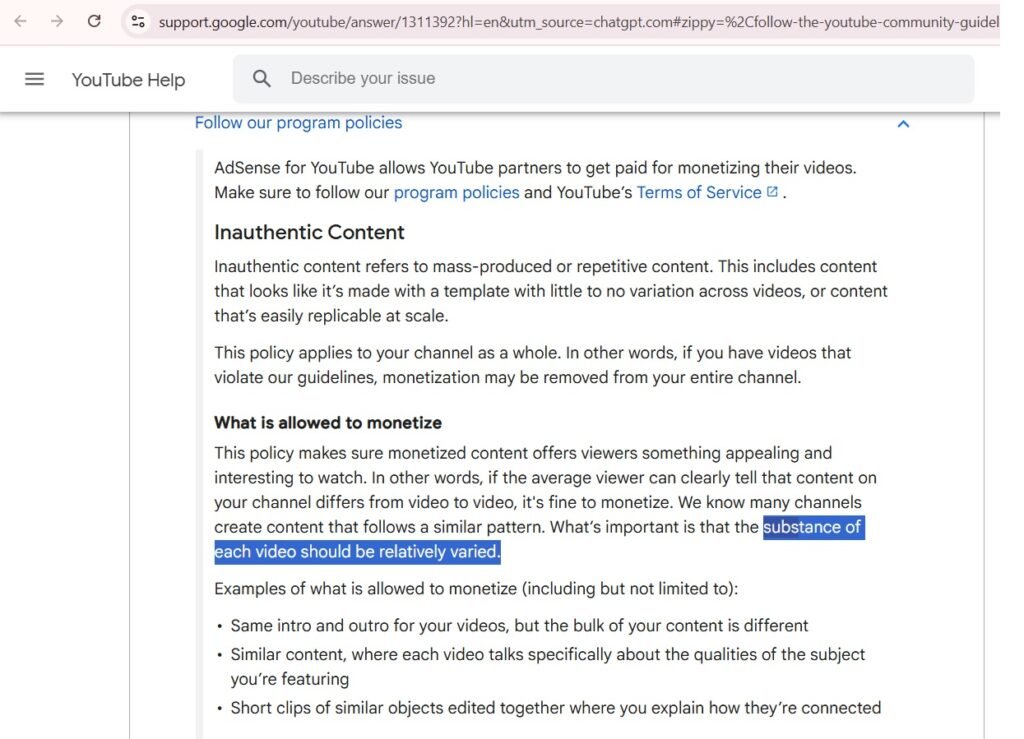
So, If you’re writing your own script, doing your own research, using your own voice (or even well researched and well thought AI voice), and putting in effort to produce value, your faceless channel is safe and monetizable.
Myth #3: “Stock Footage Will Get Your Channel Demonetized”
Again, this one is highly misunderstood and unnecessary scaring creators. Stock footage is not banned from monetized videos. YouTube understands that not every creator has access to a film crew or shoots their own visuals. Using platforms like Pexels, Storyblocks, or Envato Elements is absolutely fine, if you use them responsibly.
Where it becomes a problem is when your entire video is just bunch of unrelated or overused stock clips, with zero commentary, story, or original context. In that case, YouTube sees the video as lacking transformative value. Which mean if you just stitch some videos of mountain, lakes and waterfalls and put a meditation music behind it and narrate AI voices like “Life is a journey”, “Success is a journey” and publish it as a motivational video, that’s a problem and such videos can’t be monetized. But if you’re: Teaching something, Telling a story, Narrating a well-written script, And using stock to illustrate your point, that’s perfectly fine and absolutely monetizable.
YouTube’s official stance says:
“Be your original creation. If you borrow content from someone else, you need to change it significantly to make it your own.”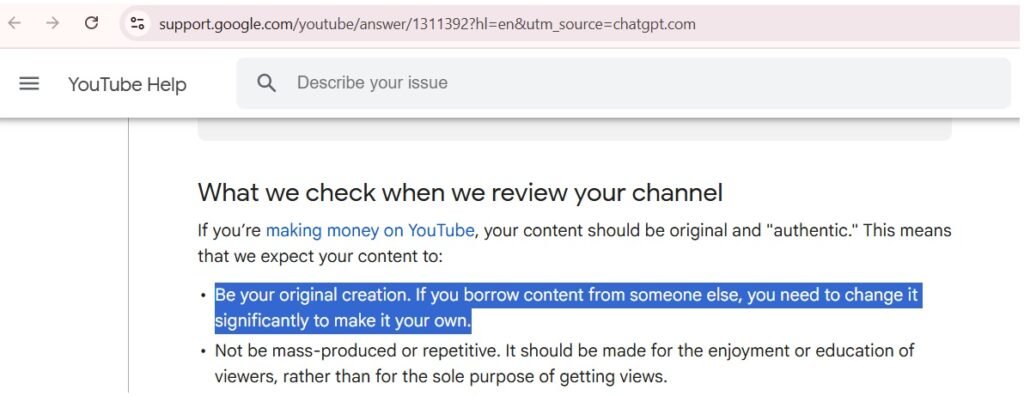
So the rule is simple: don’t let stock footage carry your video. They’re meant to support your voice and concept of the video and not replace it. Add your own commentary, narrative structure, opinion, or story. If you’re doing that, then using stock footage is absolutely fine for monetization.
Myth #4: “You Can’t Upload Videos in Bulk Anymore”
Well, again not fully true. There’s a difference between uploading in bulk and uploading junk, thoughtless mass-produced content. YouTube is absolutely fine if you try to be productive, consistent, or even publishing daily videos, provided that your content is varied, original, and offers real value.
The confusion is because of the term “bulk content.” YouTube updated its policy to clarify that they are targeting low-effort, repetitive formats, not creators who batch-record and post consistently.
Here’s the key quote from their update:
“We’re making a minor update to our ‘repetitious content’ policy … This type of content has always been ineligible for monetization … Content should … not be mass‑produced or repetitive.”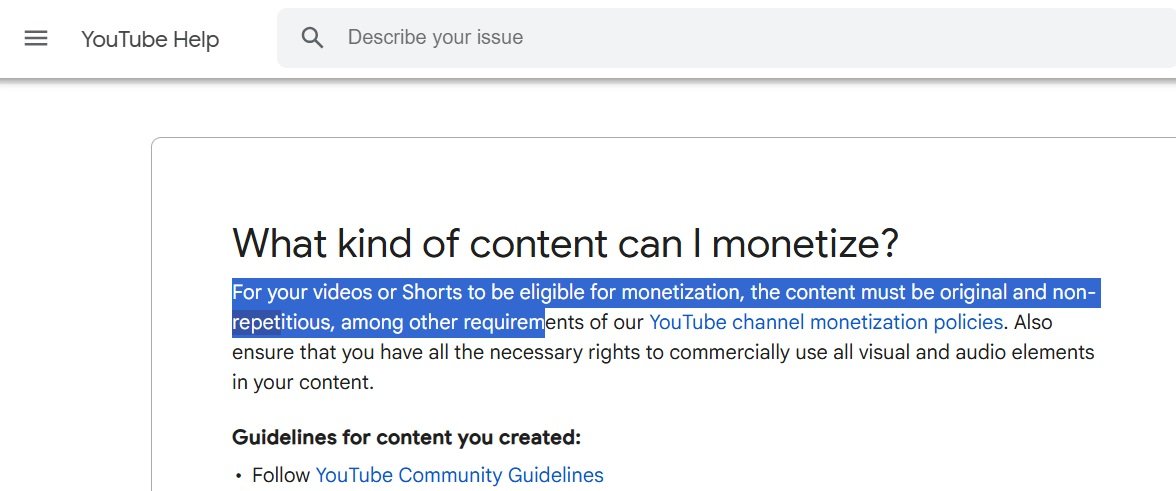
There is no problem in uploading multiple videos every week, even every day, if you’re putting your efforts and showing some creativity in each video you upload. It’s not about quantity. It’s about quantity + quality.
Myth #5: “YouTube Is Only Targeting Small Creators”
Nope.Well that’s not true This is across the board and is affecting all creators equally. Whether you have 500 subscribers or 500000 subscribers.
In fact, there are some big automation channels with a large number of subscribers which already got demonetization warnings, or some already demonetized proving that YouTube’s review systems are being applied fairly to all the channels. The goal isn’t to punish small creators; it’s to promote authentic content creation regardless of channel size.
“This policy applies to your channel as a whole. … If you have videos that violate our guidelines … monetization may be removed from your entire channel.”So yes, small creators should be careful, but so should big ones. YouTube is focused on viewer experience, and every channel has to play by the same rules now. So don’t think that you will get away from this policy as you are too small or don’t think that bigger channels won’t be affected by this policy as they are too big.
“Now, when this policy update was first announced, the internet kind of exploded. Creators were worried, thinking this was a huge crackdown or a total shift in direction. But shortly after all that buzz, YouTube actually had to step in and clarify: this wasn’t a brand-new policy at all. They said
‘This is a minor update to a rule that’s been in place for years. We’re just clarifying and enforcing it better now.’ 
So, really, it’s not about scaring creators. It’s about encouraging better, more original content, and making sure viewers get real value.
What You Should Actually Do Now (Post-Update Strategy)
Okay, so we’ve clarified some common myths about youtube’s new monetization policy. Now let’s talk about what you, as a creator in 2025, can do to stay safe, stay monetized, and still grow regardless of the current size of your channel.
1. Use AI as a Tool and Not a Creator as a Whole
Imagine AI is like a bicycle. It can help you move faster and go from one place to another, but you still need to steer and paddle it. Similarly, think of AI as your creative assistant. You can use it to brainstorm ideas, titles, outline scripts, improve grammar, or even generate visuals, but the core idea and creative intent should come from YOU. So, don’t let AI do everything, because in that case you’re not really creating anymore. You’re just clicking buttons.
Don’t just feed ChatGPT a prompt, record AI generated voice, and call it a day. That’s not how content creation works, that’s content duplication. Use AI to enhance your speed, workflow, and polish but never outsource your entire creativity to it.
YouTube is fine with AI. But they want to see that the human behind the channel is still doing the thinking and creative work.
2. Add Value Every Time You Upload
Before uploading, ask yourself: “If this video didn’t exist, would anyone miss it? Or will it make any different?” If the answer is “no,” then it might need more work.
Your video should solve a problem, tell a story, or teach something in a way no one else has. Even if the topic’s been done before, your perspective makes it different. Let me give you a super basic example: There are thousands of “how to” videos on YouTube. But if YOU have a unique method, or a funny story to show the trick, or a visual that makes it easier for kids or a specific set of target audience to understand,that’s your value. So don’t be scared of common topics. Just make sure you’re bringing your creativity to the table.
Even if you’re covering a popular topic, your take on it matters. Maybe it’s your tone, your storytelling, your editing style, or your examples. You need to give your audience a reason to care.
3. Mix Visuals With Original Commentary
Stock footage, B-roll, and AI visuals are all amazing tools, but don’t make them the main dish. They should complement your script, enhance your script and engage viewers and must not replace your script. Think of visuals like icing on a cake. It’s nice, It helps to make the cake look more beautiful and makes it more tasty, but nobody eats just icing with no cake.
Make sure your videos have your voice, your commentary, your insights, your structure. You’re the storyteller, not the slideshow presenter. Think of visuals as your background band, not the headline act.
Add motion graphics to keep things engaging. Use AI-generated images as backdrops, but keep your narration, ideas, and personality at the center. Your commentary, your thoughts, your voice, your structure, is what makes your video original. Without that? It’s just moving pictures.
4. Diversify Your Content Library
This one’s especially important for people using templates or automation tools. Well I absolutely understand that systems are helpful. Maybe you use a similar structure for each video. But don’t just copy-paste the same format 100 times with tiny changes. Why?
YouTube is now checking for repetition across your channel. So if all your videos follow the same intro, same visuals, same voice, same topic angle, then you channel might get flagged as repetition content.
Switch it up! Try:
- Changing your opening style
- Adding humor or storytelling
- Mixing up visual formats
- Covering the same topic from different perspectives
- Change angle or storytelling style
- Mix tutorials, commentary, and reactions if you can
The goal is to make sure each video feels like its own experience, even if it fits your niche. Keep your audience (and the algorithm) engaged by keeping things different.
It’s Not About Fear, It’s About Focus
So the bottom line is, you neither need to quit using AI, nor need to show your face. You just need to show your efforts and creativity. Because effort, originality, and real value are the things that will keep your channel safe, strong, and growing in this new competitive era of YouTube. So, remember,
- AI voices are Allowed but with your own creativity.
- Faceless content is Still monetizable but with originality.
- Using Stock footage is Safe, if paired with your own ideas.
- Uploading Bulk content is fine, if not spammy or all the same.
- YouTube’s rules Apply to everyone, weather big or small creator
Now I want to hear from you!
- Are you using AI in your content workflow?
- What kind of channel do you run?
- Are you planning to change your content strategy after this update?
Drop your thoughts in the comments. Let’s help each other grow, adapt, and win together.
If this post helped you out, feel free to share it with a creator friend, or post it in your favorite YouTube support group.
Stay creative, stay compliant, and keep making content that matters.
Frequently Asked Questions (FAQ’s)
1. Is it true that YouTube has banned AI voices for monetized content?
No, not at all. YouTube hasn’t banned AI voices. What they’ve done is update and clarify their stance on low-effort, mass-generated content, which often includes poorly used AI voices. If you’re using tools like ElevenLabs or any TTS engine to narrate your own original script, with thoughtful insights or storytelling, you’re absolutely fine. AI voices are allowed, as long as the content itself is valuable and human-driven.
2. Can I still run a faceless channel and earn money on YouTube?
Absolutely, yes. You don’t need to show your face to build a successful, monetized channel. Many top channels in niches like storytelling, education, finance, or documentaries are faceless. What matters is not being faceless, but being thoughtless. As long as your content is original, engaging, and provides value, being on or off camera is entirely your choice.
3. Is using stock footage now considered “reused content” by YouTube?
No. YouTube allows stock footage as part of your creative process. What they discourage is slapping together stock clips with no voice, script, or commentary. If stock visuals support your script, narration, or storytelling, great! Just don’t rely on stock alone. Think of it as a visual support system, not the star of the show.
4. What does YouTube mean by “repetitious content”?
“YouTube’s ‘repetitious content’ policy” refers to videos that are nearly identical in structure, script, and format, often posted in bulk. This includes things like:
Repeating the same narration with slightly different titles
Using the same visuals or scripts with tiny variations
Mass-uploading templated videos using AI
You can still post frequently, but each video must feel like a unique, valuable experience, not a clone of your last upload.
5. Can small creators get demonetized even if they follow the rules?
Technically, yes, but it’s rare if you’re doing things right. YouTube’s policies apply to everyone equally, big and small. If your content violates monetization rules (like reused content, spammy uploads, or copyright issues), your monetization could be affected. But the platform isn’t targeting small creators. In fact, large channels have also been demonetized recently for similar issues. So stay compliant and you’re safe.
6. How can I safely use AI tools in my content creation?
The safest and smartest way to use AI is to treat it as a tool, not a creator. You can use AI for:
Brainstorming ideas
Drafting outlines
Voiceover narration (if paired with your original script)
Generating visuals or B-roll
Just make sure the core content, your script, insight, structure, and value, is your own. Don’t rely on AI to create and upload content blindly. That’s where you get into trouble.
7. Is uploading videos in bulk still allowed?
Yes, but with a catch. YouTube doesn’t care if you post daily or even multiple times a day. What matters is quality. If you’re pushing out high-value videos that are well-produced and helpful to viewers, there’s no issue. But if you’re using AI to mass-produce cookie-cutter videos, that’s when you risk being flagged for “repetitious content.”
8. Why did YouTube say this was a “minor update” if everyone’s talking about it?
That’s a great question. YouTube clarified that this monetization update is not a brand-new policy, but rather a reinforcement and clarification of existing guidelines, especially around reused and repetitive content. They’re simply enforcing rules more strictly now, with better tools and transparency. The buzz online made it seem bigger than it really was, which is why YouTube had to calm the waters.
9. What type of content is at highest risk for demonetization?
Content that is:
Copied directly from other sources (like Reddit, Quora, or Wikipedia)
Narrated with generic AI voices and zero human input
Using only stock or reused footage with no added value
Uploaded in mass with little variation
Designed to game the algorithm rather than help the viewer
These are all red flags for demonetization. YouTube is pushing creators to be original, thoughtful, and provide a real human touch.
10. Can I still grow on YouTube in 2025 if I use AI and don’t show my face?
100% yes. AI is not the enemy, and neither is being faceless. What matters is how you use your tools. If your channel focuses on originality, helpfulness, and viewer experience, you’re in a great position to grow. Use AI smartly, stay creative, and build a channel that YOU would want to watch. That’s the secret.

